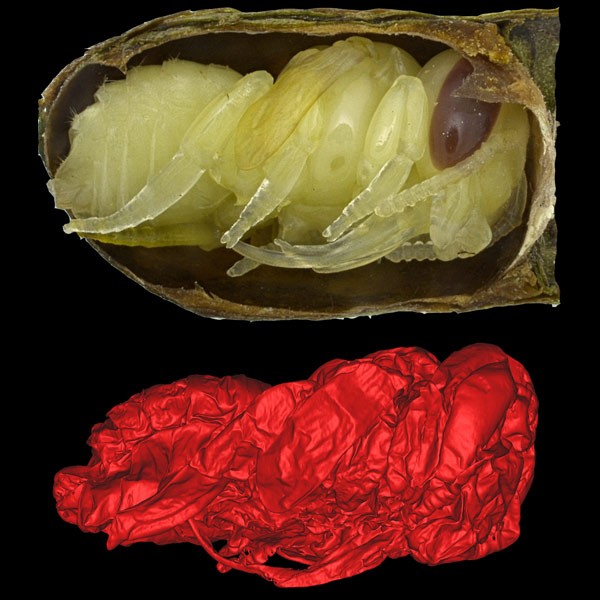PLOS ONE:小蜜蜂印证大气候

沥青坑中古老蜜蜂揭示当地历史气候。图片来源:Harold Ikerd;(底图) Justin Hall
位于美国加利福尼亚州洛杉矶市的拉布雷亚沥青坑因科学家从其潮湿环境中挖掘出无数剑齿虎、猛犸象和其他特大号生物骨骼而闻名于世。不过,有时小个头的东西才更有说服力。
近日,在线发表于《科学公共图书馆—综合》期刊的一篇论文提到,在该地区工作的研究人员目前已经鉴别出两个保存完好的切叶蜂(Megachile gentilis)蜂巢。这种蜜蜂之所以被命名为切叶蜂,是因为雌蜂会用唾液和叶汁黏合在一起的碎叶建造蜂巢。
而且,当研究人员使用微型CT扫描并窥视巢内情况时,同样发现了保存完好的切叶蜂蛹(图下)。跟现存切叶蜂蛹相比(图上),研究人员证实了分类鉴定结果,并且他们也得到了有关4万年至3.5万年前该沥青坑气候和环境的重要信息。
那时,蜜蜂在该地区四处飞舞。尽管研究小组无法判断用于筑巢的叶片的确切种类,但他们能够将范围缩小到木本树木、灌木或藤类,而非草本植物,这也反映了当地当时的植被情况。而且,当时的气候可能比较温和,因为现代切叶蜂几乎不会生活在零摄氏度以下的环境中。
原文摘要:
Anna R. Holden, Jonathan B. Koch, Terry Griswold, Diane M. Erwin, Justin Hall
The Rancho La Brea Tar Pits is the world’s richest and most important Late Pleistocene fossil locality and best renowned for numerous fossil mammals and birds excavated over the past century. Less researched are insects, even though these specimens frequently serve as the most valuable paleoenvironemental indicators due to their narrow climate restrictions and Life cycles. Our goal was to examine fossil material that included insect-plant associations, and thus an even higher potential for significant paleoenviromental data. Micro-CT scans of two exceptionally preserved leafcutter bee nest cells from the Rancho La Brea Tar Pits in Los Angeles, California reveal intact pupae dated between ~23,000–40,000 radiocarbon years BP. Here identified as best matched to Megachile (Litomegachile) gentilis Cresson (Hymenoptera: Megachilidae) based on environmental niche models as well as morphometrics, the nest cells (LACMRLP 388E) document rare preservation and life-stage. The result of complex plant-insect interactions, they offer new insights into the environment of the Late Pleistocene in southern California. The remarkable preservation of the nest cells suggests they were assembled and nested in the ground where they were excavated. The four different types of dicotyledonous leaves used to construct the cells were likely collected in close proximity to the nest and infer a wooded or riparian habitat with sufficient pollen sources for larval provisions. LACMRLP 388E is the first record of fossil Megachile Latreille cells with pupae. Consequently, it provides a pre-modern age location for a Nearctic group, whose phyloGENEtic relationshiPS and biogeographic history remain poorly understood. Megachile gentilis appears to respond to climate change as it has expanded its distribution across elevation gradients over time as estimated by habitat suitability comparisons between low and high elevations; it currently inhabits mesic habitats which occurred at a lower elevation during the Last Glacial Maximum ~21,000 years ago. Nevertheless, the broad ecological niche of M. gentilis appears to have remained stable.
标签: 小蜜蜂 切叶蜂蜂巢
作者:唐凤

